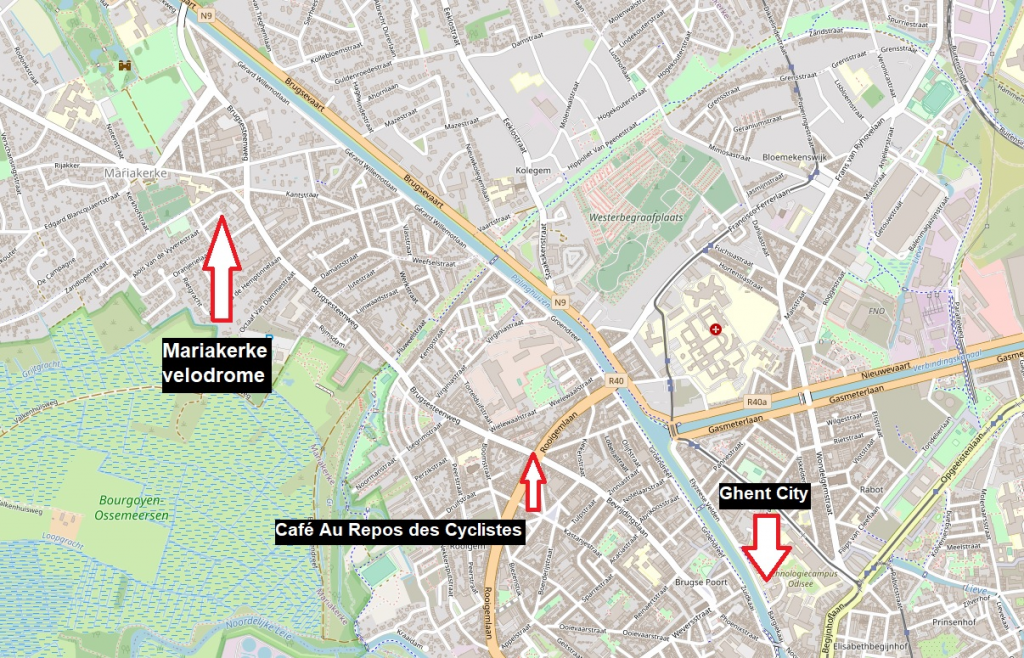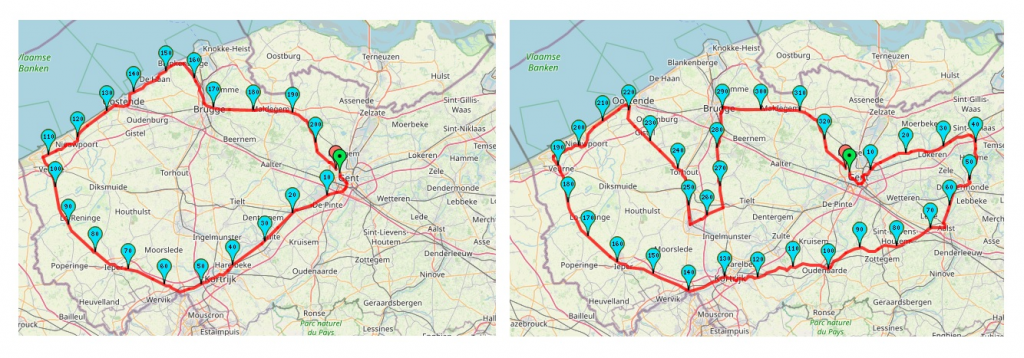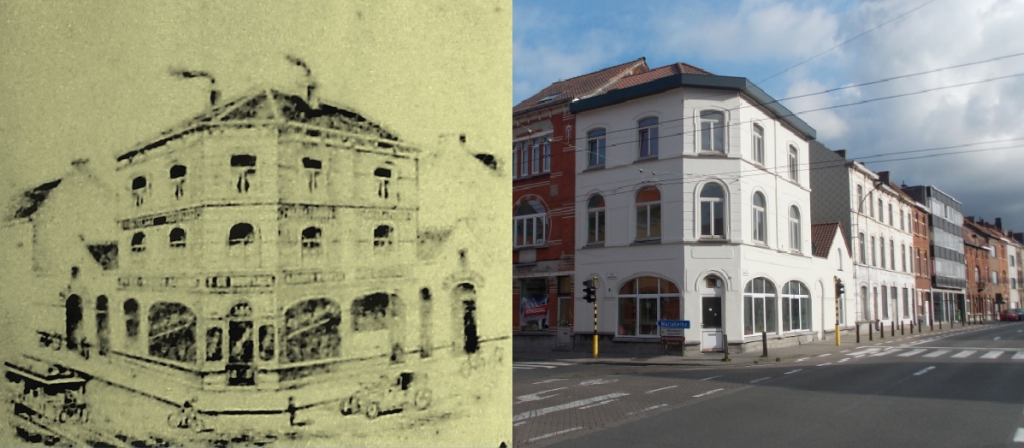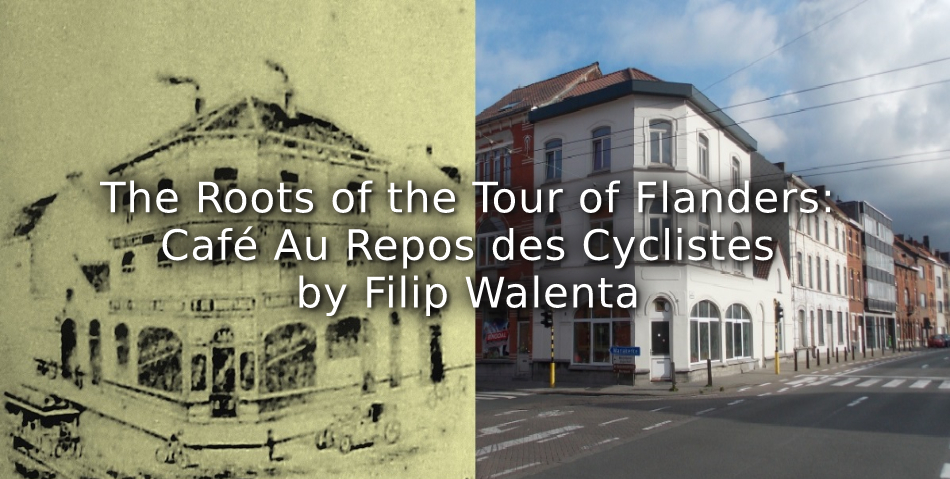Introduction
In the article ‘Reviewing the Sports Department of the 1913 World’s Fair: The Roots of the Tour of Flanders’ the predecessors of the most famous Flemish cycling classic are defined extensively.[1] Nevertheless several aspects of the early history of the Tour of Flanders are still unclear. Thanks to the increasing digitization of newspaper and book collections the last years a lot of information is unlocked and has facilitated historical research considerably. It provides researchers the opportunity to (re)discover the exact historical facts.
One of these stories is about the exact place where the first Tour of Flanders for professional cyclists took off in 1913. According to dubious resources the race started at the Koornmarkt in the center of the city. One of the three race directors and editor-in-chief of the organizing sports newspaper Sportwereld Karel Van Wijnendaele shouted standing on a chair the so-called legendary words “Gentlemen, off you go!”. New evidence shows that in this context it did not happen at all and that the real race start was located a few kilometers away. As cycling is a part of the Belgian culture and bicycle racing is recognized and declared as one of the national sports, finding the exact location of the start of the first Tour of Flanders would be as important as finding the place where the first English FA-cup or the first American Super Bowl were played.
The Forgotten Bicycle Pub
Frans Demeunynck, a bicycle seller and repairman submitted a planning permission to the municipal government for the construction of a residential building with an adjacent workshop at the corner of the Rooigemlaan and Brugsesteenweg. The vacant lot used to belong to the City of Ghent, which he had purchased for the sum of 3540 Belgian francs.[2] The planning permission was send along with the floor plan and the plans of the facade. A cycling (work)shop would be exploited at the corner while the pub was located next to it at the Rooigemlaan. The plans were approved and signed by the mayor of Ghent Emile Braun on October 5, 1908 (see picture below).

The plan of the frontage with the door of the bicycle shop at the corner and the entrance of the pub on its right.[3]

Official announcement of the board positions and affiliation to the Belgian cycling federation of the Ghent Bicycle Club in the August edition of the federation magazine.[7]
Café Au Repos des Cyclistes also regularly served as a control and supply place during long distance and stage races like the Tour of Belgium.[10] But the most important mission for Demeunynck and his cycling cafe-workshop would take place during the spring of 1913.

The location of the Café Au Repos des Cyclistes and the Mariakerke velodrome. [Google Maps]
On February 10, 1913 in the sports leading magazine Sportwereld an important change of the cycling calendar was published. The newspaper announced the organization of the Tour of Flanders for professional cyclists on Sunday the 25th of May.[11] A few weeks later the starting place was revealed: the race would start at Frans Demeunynck’s Café Au Repos des Cyclistes at the Rooigemlaan.[12] And as the day of the race approached more and more details were released. In the Friday edition of April the 4th the following article was published:
“Today we want to give a little explanation about the start of the race. Our readers already know that the start will be given at the Rooigemlaan in Ghent, across from the house of the well-known sportsman Frans Demeunynck. Everybody who knows him is assured that Sportwereld has made the best choice and everything will be well organized. The cyclists will feel at home there, the security will be well organized and the participants do not have to fear to be bothered at the start. A demarcated zone of one hundred and fifty meters will be traffic-free and assure the proper functioning of the members of the organization, the riders and their entourage. What’s more, Mr Demeunynck has several bedrooms available where the riders can spend the night at very moderate prices, and also a big workshop to park the follow cars. For all these advantages we have chosen the Café Au Repos des Cyclistes as our take-off location, and we are convinced that everybody will support our decision. The start is scheduled at five o’clock in the morning, as we wish to see the first riders arrive around four in the afternoon in the Mariakerke velodrome.”[13]
Article 5 of the rules of engagement mentioned that
“… The racing machines will be sealed with a piece of lead. In case of severe breakdown the participants are allowed to repair the damage, to change the wheel, handlebar, saddle or pedals, but continuing the race with another bicycle is prohibited.”[14]
As a result the day before the race all the bicycles were sealed by race director Karel Van Wijnendaele and Demeunynck in the workshop while the first curious spectators tried to catch a glimpse of the sport celebrities. After a short night on Sunday morning the jersey numbers were distributed while an immense crowd gathered in front of the cafe. The Ghent Bicycle Club members will undoubtedly have contributed to the entire event, they probably helped with the preparations and fulfilled the role of law enforcement at the start. At 06:15 a.m. a gunshot suddenly resounded and in front of a sea of people the cycling peloton of thirty seven riders took off followed by three support vehicles.[15]
‘Gentlemen, off you go!’
So, the legendary story of May 25, 1913 at the Koornmarkt where Karel Van Wijnendaele standing on a chair shouted to the riders ‘Gentlemen, off you go!’ can hereby be banned to the realm of fiction. Although … it does not mean that the event never took place or that the inner city of Ghent never was involved in the history of the Tour of Flanders.

The official starting location of the 1923 Tour of Flanders (indicated by the white banner on the background) at the Brugsesteenweg in Mariakerke
Race director Karel Van Wijnendaele standing in the car leads the pack out of the city.[16]
On March 23, 1919, only four months after Armistice Day, the third Tour of Flanders was organized. This time the ceremonial start was located in front of Café Sportwereld next to the city hall of Ghent.[17] The owner of Café Sportwereld Albert Carlier, was also a journalist of Sportwereld and manager of the Arsenal Velodrome.[18][19] This velodrome was situated in Gentbrugge at the Southeastern outskirts of the city, where the Tour of Flanders finished from 1919 till 1923. In the nineteen twenties the location of the ceremonial start often changed but was always located in the center of the city. From 1927 till 1932 Café Rotterdam at the Korenmarkt was chosen, the pub of former cyclist Pierre Vandevelde.[20][21] The aforementioned famous “Gentlemen, off you go!” scene most probably dates from this period, although until his early death in 1930 the general manager of Sportwereld Leon Van Den Haute always started off the race and not Karel Van Wijnendaele.[22]
From the ceremonial starting place in the city center the cyclists had to ride individually to the administrative start location at the pub of Demeunynck where the names of the participants were checked. Finally a follow car of the race direction guided the pack to the official race start outside the town.
The Track on a Bear Mat
Another blurry story that is still circulating is about the track of the first Tour of Flanders. According to the dubious resources the track of the race was drawn in September 1912 by the sports journalist Karel Van Wijnendaele on a bear mat in a pub after a tip by the 1912 Tour de France winner Odile Defraeye.[23] However, by studying the tracks of the 1911 Groote Leieprijs and the 1913 Tour of Flanders it was quite remarkable that they resembled in many aspects.[24] There was a difference of more than hundred kilometers indeed, but especially the succession of the crossed cities along the Southwestern and coastal parts were remarkably similar. So, the hypothesis that the track of the 1913 Tour of Flanders was based on the 1911 Leieprijs is quite credible. As a result the old story can also be banned to the realm of fables.

The track of the Groote Leieprijs (200 km) on the left, the Tour of Flanders (330 km) on the right
Conclusion
Frans Demeunynck’s infrastructure and his Café Au Repos des Cyclistes in particular were very important links in the development of competitive cycling in Ghent, and in the prehistory and the organization of the first years of the Tour of Flanders. The pub and the workshop were the logistical and administrative center of the whole starting event. The Ghent Bicycle Club laid the foundations of the Tour of Flanders by organizing the Groote Leieprijs that, as a consequence, can be considered as its organizational precursor.
From the nineteen twenties the starting locations and tracks of the Tour of Flanders often changed. As a result the role of Demeunynck’s pub during its first years came more and more to the background. Gradually the early history of Flanders most famous cycling classic got forgotten. At the same time mixed up events, facts taken out of their context and made-up stories through ignorance, know-it-all pedantry and personal media lust began to circulate in the cycling world. Unfortunately some of these fairytales started to live their own lives and were picked up into the collective memory, while the real historical facts were totally erased, … until now.
The Groote Leieprijs and the Ghent Bicycle Club were condemned to oblivion, but the Café Au Repos des Cyclistes has survived the test of time. The architectural heritage of the first Tours of Flanders still exists as Café De Kroon (The Crown Inn) and is silently waiting to reveal its rich sports historical past.

Left a pencil drawing of Café Au Repos des Cyclistes, on the right a recent photo of cafe De Kroon (The Crown Inn) at the corner of the Rooigemlaan and the Brugsesteenweg.[25]
Article 2022 © Filip Walenta
Project Karelvanwijnendaele.be
References
[1] Walenta, Filip, ‘Reviewing the Sports Department of the 1913 World’s Fair: The Roots of the Tour of Flanders’, Playing Pasts, (2021).
<https://www.playingpasts.co.uk/articles/cycling/reviewing-the-sports-department-of-the-1913-worlds-fairthe-roots-of-the-tour-of-flanders/>
[2] Vooruit, October 31, 1908.
[3] Eigendom Mr Frans Demeunynck – Hoek Brugschensteenweg en Rooigemlaan, 1908, Ghent. (Photo: Ghent archive De Zwarte Doos, Ghent).
[4] Vaderland, July 6, 1911, 4.
[5] Derwael, Joachim, Sociale achtergrond van de Gentse sportverenigingen en hun bestuurders op het einde van de negentiende en het begin van de twintigste eeuw (1890-1914), (Master paper UGent, Ghent 2000).
[6] Ligue Vélocipédique Belge, Bulletin Officiel Mensuel, August 1909, 5.
[7] Ibid.
[8] HLN, September 8, 1909, 3; Vaderland, July 5, 1910, 4.
[9] The ‘independent’ riders were a category of semi-professional cyclists, who did not have a contract with the pro teams.
[10] Het Nieuws van den Dag, May 2, 1909; La Dernière Heure, May 21, 1911; Het Volk, May 24, 1911.
[11] Sportwereld, February 10, 1913
[12] Ibid., March 17, 1913.
[13] Ibid., April 4, 1913.
[14] Ibid., May 14, 1913.
[15] Ibid., May 26, 1913.
[16] Photo: Luc Fortie, heritage society Marka, Ghent.
[17] Sportwereld, March 6, 1919.
[18] Ibid., March 10, 1919.
[19] Ibid., April 29, 1919.
[20] Sportwereld, April 2, 1927; March 24, 1928; March 16, 1929; April 13, 1930; March 21, 1931; March 12, 1932.
[21] Pierre Vandevelde was the winner of the 1916 Tour of Flanders that was ridden in the Gentbrugge velodrome.
<https://meemoo.be/nl/persberichten/vergeten-ronde-van-vlaanderen-ontdekt> (Accessed: March 18, 2022).
[22] Sportwereld, April 4, 1927, Ibid. March 18, 1919,
[23] Walenta, Filip, ‘Reviewing the Sports Department of the 1913 World’s Fair: The Roots of the Tour of Flanders’, Playing Pasts, (2021).
<https://www.playingpasts.co.uk/articles/cycling/reviewing-the-sports-department-of-the-1913-worlds-fairthe-roots-of-the-tour-of-flanders/>
[24] La Dernière Heure, July 10, 1911; Het Laatste Nieuws, July 3, 1911; Vooruit, July 6, 1911.
[25] Letterhead Cycles Alerta, 1924.


![“And then we were Boycotted”<br>New Discoveries about the Birth of Women’s Football in Italy [1933] <br> Part 7](https://www.playingpasts.co.uk/wp-content/uploads/2020/09/Marco-Part-7-Boycotted-440x264.jpg)


